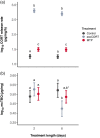Does the Glucocorticoid Stress Response Make Toads More Toxic? An Experimental Study on the Regulation of Bufadienolide Toxin Synthesis
- PMID: 37435008
- PMCID: PMC10331804
- DOI: 10.1093/iob/obad021
Does the Glucocorticoid Stress Response Make Toads More Toxic? An Experimental Study on the Regulation of Bufadienolide Toxin Synthesis
Abstract
Chemical defense is a crucial component of fitness in many organisms, yet the physiological regulation of defensive toxin synthesis is poorly understood, especially in vertebrates. Bufadienolides, the main defensive compounds of toads, are toxic to many predators and other natural enemies, and their synthesis can be upregulated by stressors, including predation risk, high conspecific density, and pollutants. Thus, higher toxin content may be the consequence of a general endocrine stress response in toads. Therefore, we hypothesized that bufadienolide synthesis may be stimulated by elevated levels of corticosterone (CORT), the main glucocorticoid hormone of amphibians, or by upstream regulators that stimulate CORT production. To test these alternatives, we treated common toad tadpoles with exogenous CORT (exoCORT) or metyrapone (MTP, a CORT-synthesis inhibitor that stimulates upstream regulators of CORT by negative feedback) in the presence or absence of predation cues for 2 or 6 days, and subsequently measured their CORT release rates and bufadienolide content. We found that CORT release rates were elevated by exoCORT, and to a lesser extent also by MTP, regardless of treatment length. Bufadienolide content was significantly decreased by treatment with exoCORT for 6 days but was unaffected by exposure to exoCORT for 2 days or to MTP for either 6 or 2 days. The presence or absence of predation cues affected neither CORT release rate nor bufadienolide content. Our results suggest that changes in bufadienolide synthesis in response to environmental challenges are not driven by CORT but may rather be regulated by upstream hormones of the stress response.
© The Author(s) 2023. Published by Oxford University Press on behalf of the Society for Integrative and Comparative Biology.
Conflict of interest statement
The authors declare no competing interests.
Figures



Similar articles
-
Chemical defense of toad tadpoles under risk by four predator species.Ecol Evol. 2019 Apr 26;9(11):6287-6299. doi: 10.1002/ece3.5202. eCollection 2019 Jun. Ecol Evol. 2019. PMID: 31236221 Free PMC article.
-
Age- and environment-dependent changes in chemical defences of larval and post-metamorphic toads.BMC Evol Biol. 2017 Jun 13;17(1):137. doi: 10.1186/s12862-017-0956-5. BMC Evol Biol. 2017. PMID: 28610604 Free PMC article.
-
Choosy cannibals: Targeted consumption of conspecific hatchlings by larval cane toads is triggered by species-specific defensive toxins.Ecol Evol. 2022 Mar 1;12(3):e8655. doi: 10.1002/ece3.8655. eCollection 2022 Feb. Ecol Evol. 2022. PMID: 35261745 Free PMC article.
-
Chronic exposure to a glyphosate-based herbicide makes toad larvae more toxic.Proc Biol Sci. 2017 Jul 12;284(1858):20170493. doi: 10.1098/rspb.2017.0493. Proc Biol Sci. 2017. PMID: 28679726 Free PMC article.
-
Roles and Mechanistic Bases of Glucocorticoid Regulation of Avian Reproduction.Integr Comp Biol. 2017 Dec 1;57(6):1184-1193. doi: 10.1093/icb/icx112. Integr Comp Biol. 2017. PMID: 28985390 Review.
Cited by
-
Cinobufagin: Unveiling the hidden bufadienolide's promise in combating alimentary canal cancer development and progression - a comprehensive review.Naunyn Schmiedebergs Arch Pharmacol. 2025 Jul;398(7):8075-8089. doi: 10.1007/s00210-025-03902-9. Epub 2025 Feb 20. Naunyn Schmiedebergs Arch Pharmacol. 2025. PMID: 39976716 Review.
References
-
- Achtymichuk GH, Crane AL, Simko OM, Stevens HEF, Ferrari MCO. 2022. The choice of euthanasia techniques can affect experimental results in aquatic behavioural studies. Anim Behav 185: 1–8.
-
- Arbuckle K, Brockhurst M, Speed MP. 2013. Does chemical defence increase niche space? A phylogenetic comparative analysis of the Musteloidea. Evol Ecol 27: 863–81.
-
- Barnhart K, Forman ME, Umile TP, Kueneman J, McKenzie V, Salinas I, Minbiole KPC, Woodhams DC. 2017. Identification of bufadienolides from the boreal toad, Anaxyrus boreas, active against a fungal pathogen. Microb Ecol 74: 990–1000. - PubMed
-
- Bates D, Mächler M, Bolker BM, Walker S. 2015. Fitting linear mixed-effects models using lme4. J Stat Softw 67: 1–48.
-
- Baugh AT, Bastien B, Still MB, Stowell N. 2018. Validation of water-borne steroid hormones in a tropical frog (Physalaemus pustulosus). Gen Comp Endocrinol 261: 67–80. - PubMed
Associated data
LinkOut - more resources
Full Text Sources
